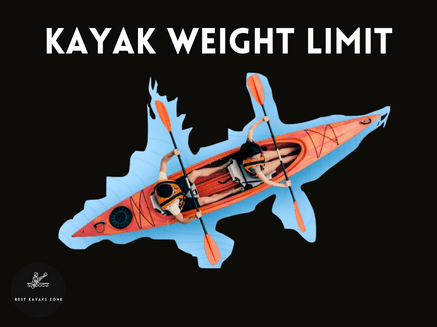Discover the thrill of 2-person inflatable kayaks—a versatile and portable watercraft perfect for adventurous duos. Designed for easy transportation and storage, these kayaks offer stability, durability, and incredible maneuverability on rivers, lakes, and even the open sea. Let the exploration begin!
Finding the ideal kayak is difficult. Many individuals focus on a kayak’s qualities and neglect its specifications. However, these features will make or break your decision on the best kayak for you.
The weight restriction for the kayak is one detail that is sometimes neglected. Each kayak has a different weight capacity. Frequently, kayaks with identical appearances have various capacities. It’s crucial to choose the proper kayak for your weight to maximize your paddling efficiency and keep you safe on the sea.
In this article, we’ll discuss how to choose the ideal kayak for your weight.

Every kayak has a specific weight capacity that guides its design for the best performance. Similar to a vehicle, it could be conceivable to pack your kayak with more weight than it is designed to support, but doing so will undoubtedly reduce its performance. Keep the weight you load into your kayak well below the rated capacity if you want to get the most out of it.
How are kayak weight limits determined?
The listed weight capacity of a kayak will typically be a little higher than what we like to refer to as its true weight capacity. So, depending on what the manufacturer claims, here is how to determine a kayak’s actual carrying capacity:
Discover The Listed Capacity
Find the maximum weight limit that the kayak’s original manufacturer advertised as a start. You might need to visit the manufacturer’s official website if you’re doing your research on Amazon or another third-party seller to uncover this capability. Manufacturers may fail to provide this information as easily as they ought to. However, you may also read through user reviews and kayak forums to gain insightful information about a kayak’s claimed weight capacity.
Increase by 0.25
After that, you should multiply the stated capacity by 0.25. Although some seasoned kayakers advise using a figure as high as 50% (0.5) for this computation, 0.25 is generally accepted as the minimum for recalculating a kayak’s maximum weight limit. Let’s take the kayak in question, which advertises a maximum Kayak weight capacity of 400 pounds. We’ll utilise the result of multiplying by 0.25, which is 100 pounds, in the following step of our computation.
Subtract your response from the capacity advertised
The weight capacity for our kayak as originally advertised will now be subtracted from our result. In the aforementioned scenario, we would deduct 100 from 400 to arrive at a real weight restriction for the kayak in the question of 300 pounds.
Utilize this calculation when loading a kayak in practice
It’s important to keep in mind that this new figure includes both our body weight and the combined weight of all the gear and supplies we typically bring kayaking. It is our realistic weight capacity for our kayak.
Calculation Of Kayak`s Weight Limit For Optimal Performance
Here’s an illustration of how to determine your kayak’s true weight capacity to bring everything together in one simple section:
400 pounds is the advertised weight capacity.
Calculation of True Weight Capacity: 400 x 0.25 = 100
400 pounds less 100 equals 300 pounds.
True Weight Limit = 300 lbs.
What Happens When A Kayak Is Overweight?
The good news is that your kayak shouldn’t capsize or sink right away if you chose to overburden it. You can get the most out of your particular kayak if you can strike the ideal balance between having it sit just right in the water and not being too high or low.
Unfortunately, depending on the type of kayak you’re working with, that balance will vary. Additionally, depending on whether you’re paddling a kayak or a canoe, the effects of overloading a kayak will vary.
WHAT ARE COMMON KAYAK WEIGHT LIMITS?
Kayaks usually come with different weight limits. Here are various kinds of weight limits for a kayak:-
Recreational Kayak Weight Limit
Recreational kayaks are often the most basic types available, and they aren’t designed to hold a tone of extra stuff. These kayaks often have average weight restrictions of 250–300 pounds.

Touring Kayaks
Touring kayaks are made for solo paddlers who want to go long distances and occasionally wish to have the option of hauling a portable camping arrangement. The typical weight limit for this kind of kayak is therefore between 300 and 350 pounds.
Fishing Kayaks
Fishing kayaks normally have average weight limitations between 350 and 400 pounds because they are designed to hold all of the necessary kayaking and fishing gear you’ll need for a full day on the water. However, it’s also very simple to obtain models with significantly higher weight capacities.
Inflatable Kayaks
It might surprise you that some of the top inflatable kayaks on the market today have relatively large weight capacities compared to other kinds of kayaks. In general, inflatable kayaks have a weight capacity of 400–750 pounds.
Tandem Kayaks
The greatest reported weight limit you’ll find on the market is frequently found in this model of kayak, which is designed for two (or occasionally three) paddlers. These kayaks typically have a weight capacity of 500–600 pounds.
High-weight Capacity Kayaks
Touring, ocean, and recreational kayak weight limits range from 200 to 450 pounds. Kayak weight capacities for fishing kayaks range from 400 to 550 pounds and higher. Additionally, the weight capacities of tandem kayaks range from 450 to 700 pounds and beyond.
Kayak Pelican Weight Limit
What Weight Do Limits Apply to Pelican Kayaks? Depending on the model, the maximum weight capacity of a Pelican fishing, touring, or recreation kayak can range from 200 lbs to over 425 lbs. Some of the most well-liked touring and recreational kayaks on the market are made by Pelican. There are kayaks available to accommodate almost any weight requirement.
Kayaks With A 300lb Weight Limit
A manufacturer’s stated kayak weight restriction of 300 lbs corresponds to around 180 pounds of useable performance kayak weight capacity using our formulas and guidelines from the example above. Keep in mind that the weight of the person and the equipment must be taken into consideration. In other words, you’re talking about a person who weighs about 155 pounds, plus 25 pounds of gear.
Kayaks With A 400lb Weight Limit
We have 240 pounds of performance kayak weight capacity based on a manufacturer’s stated 400 lb kayak weight limit (capacity). A 215-pound person with 25 lbs of gear totals that.
500 Lb Kayak Weight Limit
Assuming our calculations are correct, a kayak with a 500-pound weight limit allows us to use up to 300 pounds of performance weight. Most kayaks have a weight limit of 500 lbs, ensuring safe and stable paddling. Exceeding this limit can compromise stability and buoyancy, leading to potential accidents. It’s crucial to check the weight limit specified by the manufacturer before embarking on any kayaking trip. Always prioritize safety when enjoying water activities like kayaking.
Conclusion:
Knowing your weight and the weight of the gear and equipment you plan to bring on your trip is important when purchasing a kayak. The optimal weight restriction provides space for the paddler, gear, and equipment, while the weight limit printed on the boat refers to the greatest load it can support.
When choosing a kayak, think about choosing one with a weight capacity sufficient to hold you and all the stuff you plan to bring.
FAQS:
Can you kayak if you are overweight?
Anyone of any size or shape can enjoy kayaking. Kayaking may be fun for everybody, even if you’re overweight or taller than normal. You might be concerned about your higher center of gravity, the need for more space in your kayak for your legs, the sitting requirements, the weight restrictions, or getting into and out of the kayak is challenging.
Where should the heaviest person sit in a kayak?
It is safe to paddle with the bulkier guy at the back. It can be challenging to strike a balance between the heaviest and those with the greatest canoeing expertise. Ideally, the larger person will paddle from the stern while simultaneously being the more experienced paddler.
Does staying below a kayak weight limit mean you will stay dry?
Even if you remain within the kayak’s weight restriction, you might not stay dry. You run a higher danger of capsizing in turbulent waves if you weigh more than the kayak is designed to hold. However, staying beneath it does not ensure that you will keep dry. It needs strong paddling abilities, decent balance, and the capacity to read water conditions to keep dry when paddling.



